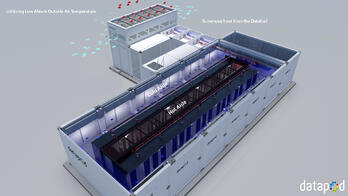This article on data center free cooling is a follow up to ENERGY EFFICIENT DATA CENTER: KEY FACTORS IN MODULAR EFFICIENCY published early this month on the Datapod Blog.
In this blog we take a look at free cooling and how it is used to improve data center efficiency.
Green Grid recently published survey results on the use of natural or free cooling in data centers and the survey found that half of respondents are now using natural cooling to save on energy costs and 25% are considering adopting the free cooling data center methods in the future.
In the Green Grid survey the average PUE of surveyed data centers using natural cooling was 1.56; the average for data centers not using natural cooling was 1.83. This means that for each kilowatt of electricity used to power their IT equipment, datacenter users that utilize free-cooling are using on average 270 kilowatts LESS power than non-optimized datacenters
This is a significant difference and for organisations with large IT infrastructure that difference would result in electricity cost savings of millions of dollars over the lifetime of those data centers as well as reduced water consumption and carbon emissions.
So what is free cooling and how does Datapod utilise this technology in the Datapod modular data center system?

Free cooling is defined by Wikipedia is an economical method of using low external air temperatures to assist in chilling water, which can then be used for industrial processes, or air conditioning systems.
When outdoor temperatures are lower relative to indoor temperatures the system utilizes the cool outdoor air as a free cooling source. As well as saving on energy, water and reducing carbon emissions, reliability is also improved as there are fewer components that are likely to fail.
There are three types main of free cooling:
- Air-side free cooling, where outside air is brought into the data center directly through filters or indirectly through heat exchangers.
- Adiabatic where the air is brought to a chamber and used along with water evaporation to cool the air.
- Water-side free cooling, where additional cooling coils can be integrated into the air-cooled chillers to pre-cool the coolant before it reaches the compressor, reducing the amount of mechanical cooling required to meet load requirements.
The Datapod system utilises the latter – Water-side economisers which take advantage of a regions lower ambient air temperatures.
Cooling in the Datapod System is done within the Utilitypod. The Utilitypod can be configured to include a waterside economizer option that can be used in cooler climates to dramatically improve the overall energy efficiency of the cooling system.
The Datapod system is available in both DX (refrigerant gas) and Chilled Water variants, with the Chilled Water versions better suited to larger, higher IT density systems. These systems work by drawing ambient air over the cooling coils of the air-cooled chillers with integrated economizers, which in turn cools the refrigerant waterglycol mix.
This coolant is then pumped into the Inrow Cooling Units within the datahall. The Inrow Coolers draw the warmer exhaust air from the IT load in, and transfer the heat to the coolant where it is then pumped back to the cooling coils of the chiller units, where it can be ejected to the atmosphere. Within the datahall the Inrow Coolers push the cooled air out to the front of the IT systems where it is once again drawn in to provide cooling.
A modular Datapod data center operates like a server by drawing in highly filtered fresh air and matching air supply to IT demand, and then extracting the hot air from the central ‘hot-aisle’.
To take full advantage of free cooling a temperate or cold climate is ideal. In many climates, data center managers can help reduce their cooling costs by also raising the set-point at which their IT systems are operating. Under ASHRAE guidance, many datacenter managers are raising the temperature at which treated air is supplied to the datacenter to around 80˚F (27˚C), which means even less mechanical cooling is required, further reducing costs and carbon footprint, taking advantage of outside environmental conditions to cool IT equipment.
Datapod’s Utilitypod can also be used to augment existing data center infrastructure, such as existing bricks and mortar data center infrastructure or can be added to existing Datapod Systems as extra capacity is required. Like all Datapod System components the Utilitypods are factory made and tested before deployment.
Key take-a-ways of Datapod’s data center free cooling:
- Significantly reduces energy consumption.
- Significantly reduces water consumption
- Significantly reduces carbon emissions
- System scalability.
To find out more about the Datapod System speak to a consultant or download the Datapod White Paper.
